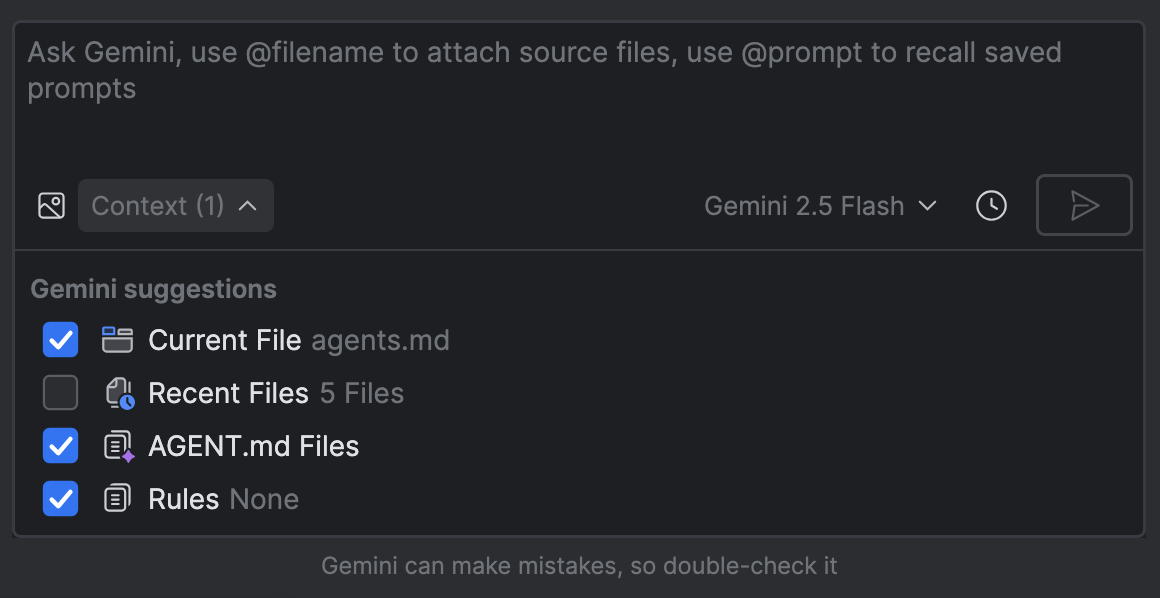אתם יכולים לתת ל-Gemini ב-Android Studio הוראות מותאמות אישית לפעולה באמצעות קובץ אחד או יותר של AGENTS.md. קובצי AGENTS.md ממוקמים לצד הקבצים האחרים בבסיס הקוד, כך שקל להכניס אותם למערכת בקרת הגרסאות (VCS) ולשתף עם כל הצוות הוראות ספציפיות לפרויקט, כללים לסגנון קידוד והנחיות אחרות.
תחילה, מבצעים את הפעולות הבאות:
יוצרים קובץ
AGENTS.mdבכל מקום במערכת הקבצים של הפרויקט. כששולחים שאילתה, Gemini סורק את הספרייה הנוכחית ואת כל ספריות ההורה כדי למצוא קבצים מסוגAGENTS.md. מידע נוסף זמין במאמר איך פועלים קובציAGENTS.md.מוסיפים את ההוראות. כותבים את ההוראות באמצעות Markdown. כדי שהכללים יהיו קלים לקריאה, כדאי להשתמש בכותרות ובתבליטים. דוגמאות להוראות
שומרים את הקובץ ומבצעים commit למערכת בקרת הגרסאות כדי לשתף אותו עם הצוות.
ניהול קבצים של AGENTS.md כהקשר
אתם יכולים להוסיף או להסיר קבצים כהקשר לשאילתה מסוימת באמצעות מגירת ההקשר בחלונית הצ'אט.AGENTS.md האפשרויות AGENTS.md קבצים כוללות את כל הקבצים AGENTS.md בספרייה הנוכחית ובספריות ההורה שלה.

AGENTS.md קבצים כהקשר.הוראות לדוגמה
אפשר להשתמש בקובץ AGENTS.md כדי לתת הוראות לסוכן. ריכזנו כאן כמה דוגמאות, אבל ההוראות שאתם מספקים צריכות להיות ספציפיות לפרויקט שלכם.
- "הפעילות העיקרית היא
/path/to/MainActivity.kt". - "The code to support navigating between screens is
path/to/navigation/UiNavigation.kt" - "הקוד שמטפל בבקשות HTTP נמצא בכתובת
<path>". - ארכיטקטורת הפרויקט
- "Place all business logic in ViewModels."
- "תמיד צריך לפעול לפי ההמלצות הרשמיות לגבי ארכיטקטורה, כולל שימוש בארכיטקטורה שכבתית. שימוש בזרימת נתונים חד-כיוונית (UDF), ב-ViewModels, באיסוף של מצב ממשק המשתמש שמודע למחזור החיים ובהמלצות אחרות".
- ספריות מועדפות: "תשתמש בספרייה <שם הספרייה> לניווט".
- הגדרת שמות של placeholder לשירותי API נפוצים או לטרמינולוגיה פנימית: "שירות ה-backend הראשי נקרא PhotoSift-API".
- מדריכי סגנון של חברות: "כל רכיבי ממשק המשתמש החדשים חייבים להיבנות באמצעות Jetpack Compose. אל תציע פריסות שמבוססות על XML".
חלוקת קובצי AGENTS.md למודולים
אפשר לפצל קובצי AGENTS.md גדולים לקבצים קטנים יותר שאפשר לעשות בהם שימוש חוזר בהקשרים שונים:
להפריד קבוצת הוראות ולשמור אותן בקובץ Markdown אחר, למשל
style-guidance.md.מפנים לקובצי ה-Markdown הקטנים יותר בקובץ
AGENTS.mdבאמצעות הסמל@ואחריו הנתיב לקובץ שרוצים לייבא. אפשר להשתמש בפורמטים הבאים של נתיבים:- נתיבים יחסיים:
-
@./file.md– ייבוא מאותה ספרייה -
@../file.md– ייבוא מספריית האב -
@./subdirectory/file.md– ייבוא מספריית משנה
-
- נתיבים מוחלטים:
@/absolute/path/to/file.md
- נתיבים יחסיים:
לדוגמה, קובץ AGENTS.md הבא מפנה לשני קובצי הוראות אחרים:
# My AGENTS.md
You are an experienced Android app developer.
@./get-started.md
## Coding style
@./shared/style-guidance.md
הסבר על קובצי AGENTS.md
Gemini סורק באופן אוטומטי את הספרייה הנוכחית ואת ספריות האב כדי למצוא קובצי AGENTS.md, ומוסיף את התוכן שלהם לתחילת כל הנחיה בתור מבוא. אם לא פותחים קובץ כששולחים שאילתה, קובץ AGENTS.md בשורש הפרויקט (אם יש כזה) נכלל כברירת מחדל.
מה ההבדל בין קובצי AGENTS.md לבין כללים?
כללים מאפשרים גם להגדיר הוראות והעדפות שחלות על כל ההנחיות. עם זאת, הכללים מוגדרים בקובץ IntelliJ /.idea/project.prompts.xml, ואילו קובצי AGENTS.md נשמרים לצד קוד המקור והם לא תלויים ב-IDE. מומלץ להשתמש בקובצי AGENTS.md אם אחת מהמטרות העיקריות היא לשתף את ההוראות עם הצוות.

